American travelers arriving in Europe this week have been met with hours-long waits at border control, as the European Union begins enforcing its new Entry-Exit System (EES) — a major shift in how visitors from outside the bloc are processed at airports.
The system, introduced on Sunday, replaces the familiar passport stamp with a digital registration that records travelers’ fingerprints, facial image, and entry and exit details. The change affects all non-EU nationals, including U.S., British, Canadian, and Australian passport holders entering or leaving 29 European countries, most of which are in the Schengen Area.
While the system is intended to enhance security and speed up future crossings, the initial rollout has been anything but smooth. At Brussels Airport, long lines and confusion have dominated the week.
One American passenger, Rebecca Wells, who flew from Chicago to Brussels on Monday morning, described a chaotic arrival experience.
“There was nobody there to brief you or tell you what was going on,” Wells told The Brussels Times. “After about an hour, someone came by with a cart of water bottles. But otherwise, we just waited — nearly three hours in total.”
Despite the new technology, Wells said her check still felt old-fashioned: “The officer stamped my passport like normal. He didn’t take fingerprints or ask any questions.”
European officials say the disruptions are temporary and that the process will become faster once travelers have been registered in the new biometric database. Still, airports are urging visitors — especially those arriving from outside the EU — to allow additional time for border control.
Which Airports Are Reporting Delays?
Reports from travelers and airport authorities suggest that the impact of the EES rollout varies widely across Europe. Some airports are struggling to adapt, while others are introducing the system gradually.
Paris, France (CDG): Operating a hybrid system, where some passengers use the new kiosks and others go through traditional booths. The result: unpredictable lines and some confusion.
Brussels, Belgium (BRU): Currently the worst affected, with immigration queues stretching up to three hours. Airport officials have acknowledged “challenges” in integrating the new system.
Rome, Italy (FCO): A slower but steady rollout has resulted in inconsistent processing times. Delays of 30–60 minutes are being…
Read full article: Americans and Other Non-EU Travelers Face Long Waits at Major European Airports Due to New EES Border Rules

The post “Americans and Other Non-EU Travelers Face Long Waits at Major European Airports Due to New EES Border Rules” by Luka Trcek was published on 10/19/2025 by www.travelinglifestyle.net






































Leave a Reply